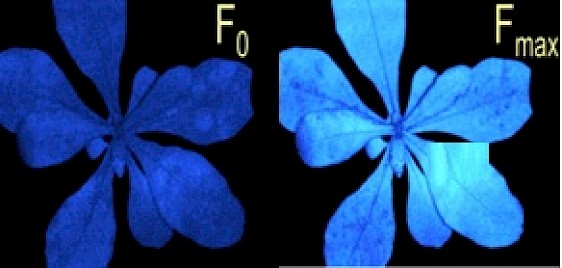
Chlorophyll Fluorescence – PAM imaging
Chlorophyll fluorescence analysis is used to measure photosynthetic parameters [5]. By exposing plants to a very bright flash of light, i.e. a saturating light pulse, the reactive centres of the plants’ photosystems become saturated. Analysing the resulting fluorescent light, information on the status and activity of the chlorophyll molecules in the Photosystem 2 (PS2) can be obtained. Methods and technology using the the Kautsky effect [6] or the PAM protocol [7] are available to record such data image-wise and implicate the data into phenotyping workflows.
Images from the PS2-cameras are processed by the LemnaTec software which extracts meaningful physiological phenotyping data, in particular chlorophyll fluorescence parameters, such as the quantum yield.
Chlorophyll fluorescence date provide insight in plant physiology and stress responses. They serve to rate plant quality in breeding, plant pathology, and environmental studies.
[5] Baker, Neil R. (2008): Chlorophyll Fluorescence: A Probe of Photosynthesis In Vivo. In: Annual Review of Plant Biology 59 (1), p. 89–113. http://www.annualreviews.org/doi/10.1146/annurev.arplant.59.032607.092759
[6] Kautsky, H.; Hirsch, A. (1931): Neue Versuche zur Kohlensäureassimilation. In: Naturwissenschaften 19 (48), S. 964. http://www.springerlink.com/index/H50128954L073U04.pdf;
[7] Schreiber U, Neubauer C, Schliwa U (1993) PAM fluorometer based on medium-frequency pulsed Xe-flash measuring light: A highly sensitive new tool in basic and applied photosynthesis research. Photosynthesis research 36:65–72 https://link.springer.com/article/10.1007%2FBF00018076
